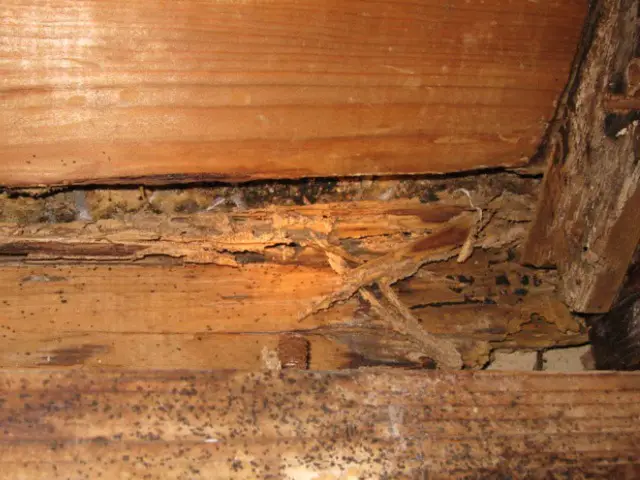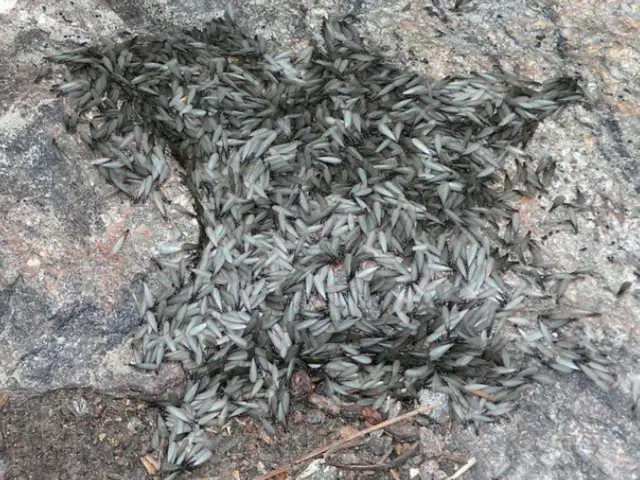Woodrats, which are members of the genus Neotoma are more commonly called “Pack rats.” Pack rats have been making the desert their home since long before the first settlers appeared in the Southwest. Arizona is home to seven of the twenty-two known species of woodrats in North and Central America.
How to keep pack rats out of homes?
Although rats like the wood rat or pack rat can be charming and adorable, you certainly don’t want them taking up residence in your home. Pack rats can cause serious damage to property by chewing belongings and spoiling food. Evidence of gnawing is the most obvious sign of a pack rat presence, as are fecal pellets (much larger than those of a mouse) and spoiled, rotting or stale food.
The best way to deal with wood rats or any rodents in human dwellings is to avoid attracting them and prevent their entry into a structure in the first place. Avoid leaving human and pet foods out, and eliminate shelter for rodents around homes. Do not allow brush, rock or junk piles to accumulate near dwellings where rats could take shelter. Rats can squeeze through any opening they can fit their head through, so homeowners should make sure their house is not accessible to rats by sealing off cracks and crevices and structural penetrations of all kinds.
If pack rats are already inside a house, the most humane option is live trapping followed by the release in the wild, preferably a good distance away but near a source of water. Poison rat bait is very dangerous to other animals and humans if consumed and also causes secondary poisoning in opportunistic predators. There are methods of baiting and trapping that can minimize these risks to other animals. Traps also permit rats to be removed from the home, thereby avoiding problems from animal bodies decaying inside walls and floors.
Taking measures to prevent infestation will greatly reduce the risk of property damage and exposure to diseases such as Hantavirus.
What do pack rats look like?
Packrats are often found as pale tan, light grey, or an amber-brown color. Many also have white bellies and feet. Their furry tails are a distinctive mark, which differs from the more infamous “roof rats.” The pack rat can range from eight to over twenty inches with their tails. These desert rodents breed often and can have up to five litters in a year, each consisting of up to five pups per litter. This means that the Arizona desert is home to millions of these nocturnal creatures.
Why are they called pack rats?
A “pack rat” has become a popular American slang saying for a person who collects items and has no ability to get rid of the collected piles of things they store. Often the things appear as junk to others, and this behavior borders as compulsive. While humans have created garages, attics, sheds, and closets to store endless amounts of junk, our desert neighbors, the pack rats, use what’s called a “midden” or nest to contain their hoarded materials. In the Arizona desert, middens are built of cholla cactus, mesquite branches, prickly pair pads, twigs, sticks, rocks, bricks, attic insulation, and any other debris the pack rats can drag into their safe haven. These nests keep the desert rodents relatively safe from their natural predators. The middens are often quite elaborate, long-standing structures, which have been carbon-dated back as far as 40,000 years old.
Packrats are always building, storing, and adding on to their middens. The desert middens are often found consisting of hundreds of pounds of materials and can range in size from a few square feet to massive mounds well over one hundred square feet. These thorny and well-insulated nests provide the desert pack rats protection from predators and the extreme temperatures of the Arizona desert. In addition, the nests are so well constructed that packrats are able to keep cooler than the desert floor in the summertime and keep their bodies warm in the near-freezing winter months.
Can pack rats damage my home?
The short answer here is yes! Packrats are very clever and curious creatures always looking to add to their middens. Your home provides these desert rodents with numerous items with which they can build upon their nests. Not only can the packrat find items in and surrounding your property, which will be useful for midden expansion, but they can also use your home as their next nest. Packrats will see your home as a craggy rock pile or giant boulder full of cavernous nooks and crannies to hide in and store endless materials. Nearly every home has an attic, storage closets, poolroom or equipment areas, barbeques, sheds, and utility rooms that a packrat can turn into a nesting place.
Packrats can be very destructive creatures in their quest to build a nest or add to their desert midden. Outdoor patio furniture is often chewed on for the desert rodents to pull the fabric off and the inner stuffing out, which is all used in midden construction. Outdoor kitchen areas with a barbeque are easily used for nest building and safe hiding places for pack rats. Any utility door or shed can be a suitable opening for a packrat to enter and build a nest. Poolrooms, pool equipment areas, and hot tub heaters are favorite spots for these desert rodents to infest and costly damage to equipment is possible.
While the outside of your home is an easy target for pack rats, it is usually the inside of your home that appeals most to their hoarding behavior. Your home’s attic space is the most desirable place for a pack rat to build a nest. A home’s attic is a perfect environment for a desert rodent such as the industrious packrat. The attic is quickly made into an ideal den for packrats as it provides a perfectly safe, dry, dark, and quiet environment in which they can store food items, hide from predators, and safely breed new offspring. The major by-product of the nesting rodents in a home’s attic is a heavy accumulation of odorous urine and a large build-up of feces or “droppings.” As much as 500 pounds of packrat waste and feces has been removed from heavily infested homes by local wildlife and pest control companies. This build-up of waste, urine, and feces is a costly mess to clean and restore and poses a very serious health risk to the inhabitants of the home. Breathing this infected air could lead to serious disease and illness.
A packrat will chew and tear almost anything in its path. Packrats will chew through wood, plastic, PVC pipes, rubber, electrical wiring, fiberglass insulation, and paper with great ease. This chewing behavior makes a home’s roof, electrical wires, plumbing, and insulation prime targets for being damaged by these desert rodents. If pack rats chew the underlayment of a tile or shingle roof, heavy rain will allow water to leak directly into the attic, walls, or home causing costly repairs. Insulation that becomes torn no longer has its proper -R-value and may contain harmful bacteria. A chewed water line could flood a home, creating mold, wood rot and costing a homeowner thousands of dollars to repair. The worst-case scenario has a chewed electrical line causing a devastating house fire, which could ruin a family’s possessions or even claim the lives of loved ones.
If you have seen signs of pack rats in your home or community, contact reputable and local wildlife and pest control company.
Information about Rat Traps
Rats can be severely hazardous for you and your kids at homes, offices and other buildings; they have reportedly been imperious because of their habit of gnawing at woodwork, water pipes and electric cables and also cause huge damage to foodstuffs. Along with such losses, rats can also be hazardous to health as they spread several diseases. Rat’s urine is known to hold bacteria that can cause Weil’s disease. It is a harmful disease with symptoms like flu. Also, rats are competent in spreading Salmonellosis, which is basically a type of food poisoning. It makes the prevention of rats in food areas critical. Moreover, rats discharge pheromone tracks that prompt a natural behavioral response of other rats. Secondly, rats have the ability to reproduce up to ten times a year. Hence, getting rid of rats can become a bit of a struggle. However, if you sensibly take the recommended preventative measures and be patient, you can easily get all rats outside your home.
In order to actually kill rats, people often make use of rat poison, but it is widely noticed that rats usually do not die, even after swallowing down major chunks of it. Hence, if you are also thinking of using the same trick, make sure to get a good rat killer poison. Secondly, in big food storage houses, people generally for an electronic anti-rat device, which is certainly effective and dangerous. Thirdly, you have rat pest control which is usually performed by professionals only. Big, huge farms use electronic scare crows that are powered by batteries and come with a combination of a sonic or ultrasonic unit. However, to no surprise, the best and most popular way of catching rats in the houses is still the traps. Traps are taken as the safest way of catching rats, and the greatest bait for trapping a rat is usually some strong-smelling foodstuff.
Trapping is a long procedure and demands a little patience from your side because rats are mostly observant and about their surroundings. Today, a huge variety of rat traps are available in the market. Moreover, the best among all such traps is “snap traps.” Greatly recommended, these traps can slay rats and mice instantly and easily. Moreover, those who have a light heart and cannot see animals in pain can also go for hidden traps.
These traps are totally covered and do not allow contact between the trapper and the dead rat. In fact, this is much more than an ideal pick for people having stomachs turn at the very thought of rats. Some of the other common types of rat traps are glue traps, fence traps, wooden traps and etc.
You can actually save yourself from the excruciating task of trapping and catching rats by simply taking certain preventions such as not leaving any foodstuff on the ground or uncovered and placing all rubbish in the dustbin. In fact, also ensure not to leave areas of your garden piled up with waste or overgrown, as rats may shell in this area. Block holes, if you have any in your house and keep all your drains covered.
Summary: Rats can survive anywhere till the time they get adequate food supplies. Farms, houses, storage places are their favorite spaces. Hence, different sorts of rat trapping products are available in different places.




